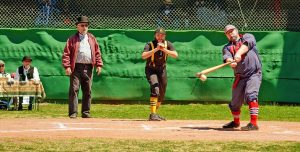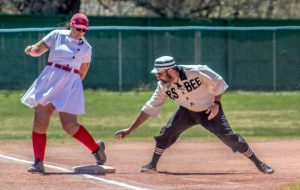- Slug: Sports-Arizona Vintage Baseball League, 1,600 words.
- 4 photos available.
By Aaron Decker
Cronkite News
BISBEE – In this historic mining town tucked into the Mule Mountains in southeast Arizona, time travel really is possible.
At picturesque Warren Ballpark, the town’s baseball field, a man wearing a top hat calls a strike, the players on the field catch the ball with bare hands, and pitchers throw underhand. The fans in the bleachers cheer and boo for teams with names like the Mesa Miners, Maricopa Maidens, Bisbee Black Sox and Higley Haymakers.
These teams play in the Arizona Vintage Base Ball League, a local league that plays a throw-back version of baseball, or rather base ball – two words, like the olden days – using rules from 1863.
The AVBBL began 15 years ago with the hope of keeping alive the sport’s rich history and providing a glimpse back at its roots.
“I’ve been playing ball since elementary school and I had no idea that this was even a game,” said Michelle Shaw, captain of the Maricopa Maidens, an all-female team that competes in retro uniforms that include skirts and knee-high socks. “It’s really cool to be aware of where baseball really started.”
The eight teams come from cities spread across southern Arizona, ranging from Yuma to Buckeye to Mesa. Throughout the fall and into the spring the teams play against each other in local parks. The season finishes in early April in Bisbee with the Bisbee Tournament, which celebrates vintage base ball by having a friendly weekend of games against local and out-of-state teams.
The league aims to replicate base ball as it would have been played in fields in the 1860s. There is a stark difference between the 12 rules used in vintage base ball and those of the modern game. For instance, pitches are tossed underhanded, foul balls are not strikes, a player is ruled out if the ball is caught off one bounce, and if the ball is caught in the air it is an out and the runners on base cannot advance.
“If you’re able to catch it in the air, that’s the ultimate play and the best tactic but it’s also the hardest thing to do,” said Patrick McLaughlin, captain of the Phoenix Senators. “So catching the ball without letting it bounce is the challenge of vintage baseball.”
The language of the game is also altered to mirror the era of the mid-19th century. A pitcher is called a “hurler,” a hitter is a “striker,” a shortstop would be known as a “short scout,” and an outfielder is a “gardener.”
Even the fans are thrown back in time and called “cranks” or “bugs.”
The AVBBL doesn’t leave authenticity just at the rules and lingo but goes as far as playing with replica balls modeled after the type used in 1870. The ball is larger and softer than a modern-day baseball, which sacrifices power but is easier to hit. During the sport’s early rendition of America’s pastime, the goal of the hurler was to present a ball that could be put into play. The days of flamethrowing pitchers and strikeouts were decades away.
“The pitcher didn’t have to be anybody who can throw really fast, they just had to get it over the plate,” said Patrick Murphy, captain of the Higley Haymakers. “In (this) aspect of it, it is a very defensive game where nowadays it’s a pitching-focused game.”
The historic transformation culminates with the vintage season’s curtain call at the 115-year old Warren Ballpark on the edge of Bisbee. The park has been in continuous use since it was built, and predates Wrigley Field in Chicago and Boston’s venerable Fenway Park.
During the league’s two-day Bisbee Tournament, players bat, field and pitch on the same field that has hosted base ball – and baseball – games since 1909.
Initially built as a site to provide positive recreational activity for the copper miners and their families in Bisbee, Warren Ballpark began to bring in major league teams such as the New York Giants and Chicago White Sox, who played an exhibition game at the park in 1913. That game featured six future Hall of Fame players and Olympic gold medalist Jim Thorpe, according to the AVBBL.
The park also gave refuge to the notorious.
During the 1920s, three players involved in the Chicago “Black Sox” scandal who were banished from the majors, played at Warren Ballpark for Bisbee’s team in the Copper League before the league folded in 1927.
“It’s really unreal … it really feels like baseball’s hallowed ground,” McLaughlin said of the ballpark, which spans approximately 40 acres and features a canopy-covered grandstand that was built in 1909 and is listed as a state historic building.
Today the field is home to the Bisbee High School Pumas baseball and football teams, but the era it was built in still lingers. The dugouts are literally dug into the field and the hallway that leads into both clubhouses requires an average-sized person to duck under the structures.
The ballpark’s preservation is aided by a non-profit, the Friends of Warren Ballpark. The president of the organization is Murphy, who also captains the Haymakers. The goal of the organization is to promote the ballpark’s history and restore and renovate it as needed.
On the first weekend in April, the ballpark hosted the Bisbee Tournament or officially the 13th Annual Copper City Classic Vintage Base Ball Tournament. It featured seven of the league’s teams as well as teams from Colorado and California.
“We call it a tournament, but it’s really more of a baseball festival,” Murphy said. “There’s no real winners of the whole weekend or anything. It’s just more of a demonstration of vintage baseball to bring the baseball enthusiasts together.
“And all of the proceeds, every penny we raise, will go back into the ballpark itself.”
The modern-day players vary from those who love the history of the game to those who have a background in playing baseball and want to continue playing the game. McLaughlin is a prime example of the league mixing old with new: The Senators’ captain was a history major in college who also loved the game of baseball.
Shaw – or Roxy, as she goes by as a member of the Maidens – was introduced to vintage base ball as a child, through the movie “A League of Their Own.” That 1992 fictional movie based on the real-life All-American Girls Professional Baseball League, continues to inspire the Maidens, an all-female vintage base ball team. The Maidens wear white or gray dresses with red belts, caps, socks and buttons when they play that are fashioned after the uniforms worn in the movie.
“It’s been so fun (these) last couple years, kind of creating, starting, and just kind of running this team and every single one of these girls just loves it so much and being part of it,” Shaw said.
The AVBBL begins its next season in the fall and holds tryouts for openings on the teams. More information on the league, teams and tryouts can be found on the league’s website.
GLENDALE – The pageantry and build-up for a boxing match is unlike anything in sports.
For Top Rank’s latest event in Arizona, the intensity began to build during the Wednesday press conference before the March bout at the Hyatt Regency in downtown Phoenix.
In the main event, former two-division world champion Oscar Valdez took on Australia’s Liam Wilson for the WBO interim junior lightweight title. In the co-main event, four belts were on the line in the minimumweight title unification bout between Seniesa Estrada and Yokasta Valle.
The tension began to build at the presser, when the four fighters answered questions just feet away from their opponents, creating an uncomfortable but unique dynamic. The fighters would then pose face to face before leaving to begin their weight cut and then weigh-ins the following afternoon.
At weigh-ins, the tensions rose even more, with the fighters pushing themselves to make their contracted weight. There is something mind-blowing about combat sports weigh-ins, knowing these fighters will batte hard the following night after pushing their bodies to the limit just to make weight.
Upon the ring of the first bell on fight night, the crowd favorites were clear. Throughout the card, many Mexican boxers took center stage, and many Mexican fans packed the house to support their fighters.
Among the fights on the undercard, Lindolfo Delgado dominated Carlos Sanchez and finished him off with a seventh round knockout after knocking him down hard in the fifth round.
As the women who were squaring off in the co-main event arrived at the ring, the tension in the building was palpable. Even thought there is respect between the fighters, their desire to get their hands on each other could be felt through Desert Diamond Arena.
In the end, Estrada outdueled Valle, winning by unanimous decision, in what could only be described as an absolute battle between two fighters with their eyes on the ultimate minimumweight throne.
In the main event, Valdez outclassed Wilson, forcing the referee to step in during the seventh round to secure his TKO victory over the Australian. Valdez, born in Nogales, Mexico, and raised in Tucson, now holds the WBO interim junior lightweight belt, hoping for the chance to unify later down the line.
“(Arizona) is my home,” Valdez said. “I was born in Nogales (Mexico), but I did my elementary school here in Tucson. I made a lot of great friends, most of my family members are still here … of course I’ve got a great relationship with Arizona. I love it.”
Valdez’s victory and the card as a whole served as quite the victory lap for the Mexican boxing community, continuing to build on the legacy of the legendary Mexican warriors that paved the way.
For more stories from Cronkite News, visit cronkitenews.azpbs.org.



